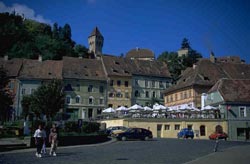| Hunting | |
| Adventure | |
| History | |
| Environment | |
| Getting Around | |
| When to Go | |
| Travels | |
| Attractions | |
| Travel Stories | |
| Our offer | |
| Contact us | |
 |
|
| Transylvania | Brasov | Bran | Scornicesti | Bucharest |
| Black Sea | Danube Delta | Fagaras | Sinaia | Bucovina |
| Maramures | Sighisoara | Iasi | Cluj-Napoca | Timisoara |
Like Brasov, Sighisoara is a Saxon medieval town surrounded by hills in Transylvania. But it is more beautiful and less hyped than Brasov, and has a greater amount of perfectly preserved medieval buildings. For many, its great drawcard is the Dracula connection - within the walls of the medieval citadel you'll find the Dracula House, in which Vlad Tepes was born in 1431 and reputedly lived until the age of four. It is now a bar and restaurant. |
 |
|||
Sighisoara's other main sights are also inside the citadel walls, with its nine surviving towers. The clock tower, a history museum and the Church of the Dominican Monastery, which became the Saxons' main Lutheran church in 1566, are all worth seeing. And don't miss climbing the 172 steps of the covered stairway to the Gothic Church on the Hill. Just 4km (2.5mi) northeast of Sighisoara is the village of Albesti, home to the Sandor Petofi Museum, which commemorates the Hungarian poet who died in battle here in 1848. Sighisoara is well serviced by both local and international bus and train services. A forbidding silhouette of battlements and needle spires looms over SIGHISOARA (Schässburg to the Saxons and Segesvár to the Hungarians) as the sun descends behind the hills of the Târnava Mare valley, and it seems fitting that this was the birthplace of Vlad Tepes, "The Impaler" - the man known to so many as Dracula . Visually archaic even by Romanian standards, Sighisoara makes the perfect introduction to Transylvania, especially as the eastbound Dacia, Traianus and Pannonia express trains all stop here, making a convenient break in the long journey between Budapest and Bucharest. Located on the Tarnava Mare River, the town was built by Saxons between the 12th and 17th centuries. Eleven towers guard Sighisoara's walls, among them Tailors' Tower and Shoemakers" Tower.From the top of Clock Tower, visitors can look down on the red-tiled roofs of the Old Town and see intact 16th century Saxon houses lining the narrow cobblestone streets. Today, merchants and craftsmen still go about their business, as they did centuries ago. Sighisoara's charming hotels, restaurants, and historic attractions make it one of the few citadels in the world where life still goes on within its walls. |
||||